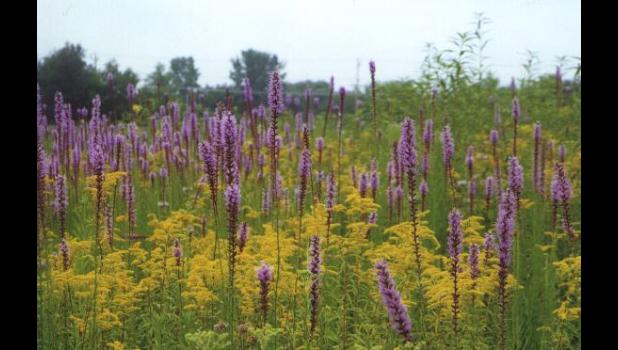Blazing Stars and Goldenrods
If you drive around the countryside this time of year, you will no doubt notice an explosion of color occurring. That’s because August is a wonderful time to see some of our native prairie wildflowers in full bloom. And, just as the spring woodland flowers do earlier in the year, the summer wildflowers put on quite a show.
Among the flowers you’ll notice along our roadsides, in fields, and in pastures are purple and yellow coneflowers, prairie phlox, milkweeds, wild bergamots (bee balm), black-eyed Susans, ironweed, and purple prairie clovers. And, you’ll also notice a couple flowers that are among the most colorful of Iowa’s native wildflowers—blazing stars and goldenrods.
Blazing stars are beautiful, tall, spiky plants that are actually members of the Aster family. They are often easy to spot in a road ditch or in a field because of the flowers’ bright purple color and because they can grow to be several feet tall. The individual flowers look like starbursts (hence the name) and begin blooming at the top of the plant and continue to bloom down the spike.
Blazing stars are iconic prairie flowers and are very important for pollinators. Their sweet nectar attracts a wide variety of butterflies and bees, and even some hummingbirds. During late summer and early fall, many blazing stars can be seen covered with Monarchs as the butterflies fuel up for their journey to Mexico.
As the blazing stars are blooming, so are the goldenrods. In Iowa, we have two main species of goldenrods. Stiff goldenrods grow tall and have domed clusters of yellow flowers on the top. Showy goldenrods also grow tall but, by contrast, have plume-like flower clusters that can reach up to a foot long.
Unfortunately, goldenrods have acquired a mistaken reputation for causing hay-fever. But, their brightly-colored, yellow flowers are used to attract bees, butterflies, and other pollinators. So, their pollen is not released into the air, where people can breathe it in, but instead stays inside the flowers where the pollinators can get to it.
But, one plant that can often be found around goldenrods is ragweed. It grows in much of the same habitat and releases its pollen at about the same time that goldenrods bloom. So, imagine it’s mid-late summer, you’re outdoors, and your hay fever kicks in. You look around and see goldenrods, but nothing else stands out. So, you begin cursing the goldenrods, not even noticing the ragweed nearby. Unfortunately, this happens all the time, giving the goldenrods a very undeserved reputation.
In reality, goldenrods are very beneficial. Besides adding a bright yellow beauty to our landscape, their flowers have a sweet nectar that is enjoyed by many insects. At a time when bee populations are declining, goldenrods provide a wonderful food source and an important source of pollen for honey. Goldenrod flowers are also visited quite often by countless varieties of butterflies, including Monarch butterflies as they head south to Mexico. The nectar provides a very important source of energy for those migrating Monarchs. And, after they are done blooming, goldfinches feast on goldenrod seeds.
Blazing stars and goldenrods are two of the flowers we recommend people plant to help restore some of our native plants and pollinators. They are beautiful and beneficial. So, as you’re driving through the countryside this summer and early fall, be sure to enjoy these colorful wildflowers. And, if you can, look closely . . . You may just see some of the bees and butterflies that depend upon these important flowers.

